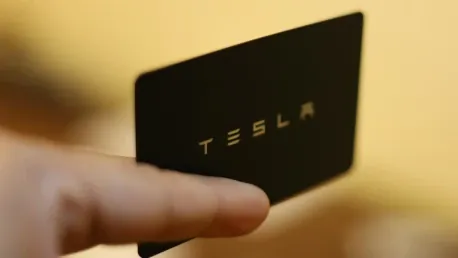Tesla Inc, a powerhouse in the electric vehicle (EV) industry led by the often controversial Elon Musk, finds itself at a crossroads. Facing a multitude of challenges, ranging from shifting political dynamics to a surge in competition, the company’s future is uncertain. With a declining market share and a polarizing CEO, can Tesla navigate the turbulent waters and reclaim its leading position?
Declining Sales and Political Fallout
Impact of Elon Musk’s Political Involvement
Elon Musk’s heightened political engagements, including aligning with controversial figures and agendas, have had a profound impact on Tesla’s sales. His involvement in dismantling U.S. government agencies and criticizing European political figures has not only drawn public scrutiny but also led to a notable drop in sales figures across key markets. These moves have generated significant backlash from various political factions and alienated segments of Tesla’s once-loyal customer base. The intertwining of Musk’s personal politics with Tesla’s corporate image has caused many potential buyers to reconsider their affiliations with the brand, further compromising its market standing.
In the highly polarized climate of today, consumer loyalty can shift swiftly based on perceived alignments with political ideologies. Musk’s actions, such as public endorsements and critical remarks about global political events, have cast a shadow on Tesla’s market reputation. This scenario underscores the broader implications of CEOs extending their influence beyond corporate matters into the volatile realm of politics. The ripple effects on Tesla’s brand value and market appeal make it critical for the company to navigate these challenges with strategic insight and sensitivity, potentially reassessing the degree of Musk’s visibility and engagement in political discourse.
Sales Declines Across Major Markets
In Europe, Tesla’s sales fell drastically, with a 45 percent decline across the region in January alone. Germany, a crucial automotive market, saw registrations plummet by 71 percent in the first two months of the year. The steep declines in Germany are particularly worrying for Tesla, considering the country’s influential position in the global automotive industry. The local market’s apparent rejection may indicate broader European sentiment, further straining Tesla’s international market performance. Elsewhere, the situation in China mirrored these trends, with shipments falling by 49 percent in February. This decline marked the lowest level since the middle of 2022, exacerbating worries about Tesla’s ability to compete globally.
Meanwhile, U.S. sales have also been sluggish, with significantly lower figures compared to previous years. Market researcher Kelley Blue Book reported Tesla sold approximately 43,650 vehicles in February, among the lowest in the past three years. The stark drop from past performances raises concerns about Tesla’s strategic positioning and market resilience. The anticipated challenge remains whether Tesla can replicate or surpass its peak sales figures in crucial markets, given the evolving competitive landscape and the added complexities introduced by political dynamics. The erosion of market share within Tesla’s largest revenue markets necessitates immediate and decisive strategic intervention.
Production Challenges and Competitor Pressure
Production Halts and Redesigns
Tesla’s decision to halt production for the redesign of the Model Y has further complicated its market position. Although intended to reignite consumer interest, the temporary halt impacted overall production and sales numbers at a critical juncture. The redesigned Model Y, meant to attract new buyers and reinvigorate brand enthusiasm, faced execution delays and operational hiccups, leading to reduced output and market uncertainty. The ripple effects of this decision were felt across various markets, contributing to the perception of inconsistency in Tesla’s product delivery cycles.
The production halt had the dual impact of constraining available inventory and creating a gap that competitors were quick to exploit. The delay in rolling out the redesigned Model Y came at a time when maintaining market momentum was crucial. Moreover, the procedural adjustments required for the new model’s assembly temporarily disrupted Tesla’s established manufacturing workflows. Although the redesign aimed to differentiate the Model Y from previous iterations, the tangible benefits are yet to be realized in broader market uptakes. The production halt without a substantial immediate boost in sales underscores the need for strategic foresight in balancing innovation with operational consistency.
Rising Competition from Rivals
The EV market is more crowded than ever, with established players and new entrants vying for dominance. One prominent rival, Chinese automotive company BYD Co, has enjoyed robust growth, thanks to its diverse model lineup and innovative battery technology. BYD’s aggressive market entry with affordable and innovative options poses a significant threat to Tesla’s market leadership. Their rapid sales surge showcased the effectiveness of providing practical and cost-efficient alternatives, fueling competition within a fast-evolving industry.
The emergence of companies like Xiaomi Corp, which is branching out from mobile phones into car manufacturing, highlights the rising competitive pressure from both traditional and non-traditional automakers. These new entrants are challenging Tesla’s standing, introducing more diverse options for consumers at competitive price points. The influx of highly adaptable competitors equipped with cutting-edge technology and pricing strategies has further intensified the market rivalry. Tesla’s current offerings need strong competitive differentiators to maintain relevance amidst a dynamic and crowded landscape. The evolution of consumer preferences towards more accessible and versatile EV options represents a strategic frontier Tesla must navigate astutely.
Market Share Erosion and Consumer Backlash
Shifts in Market Share
In the U.S., Tesla’s market share has significantly dropped from 75 percent in 2022 to under 50 percent by 2024. This dramatic decline underscores the pressing need for Tesla to reassess its strategies and address its waning influence in key markets. The erosion of Tesla’s commanding market position raises critical questions about its future trajectory amidst changing industry dynamics. The lowering percentage illustrates a growing consumer shift towards alternative EV brands, underlining the immediate necessity for Tesla to enhance its market engagement tactics significantly.
This market share erosion signals more than just numerical decline; it reflects shifts in consumer loyalties and perceived brand value. As other brands continue to capitalize on customer preferences for diversified or cost-effective solutions, Tesla must rethink its approach to competitive differentiation. The sustained loss of market share within such a crucial revenue segment complicates Tesla’s strategic landscape, emphasizing the urgency for innovative product offerings and refined market alignment. A proactive approach focusing on realigning Tesla’s core strengths with evolving market demands could potentially restore the brand’s authority in the EV domain.
Consumer Boycotts and Activism
Tesla’s alignment with U.S. President Donald Trump and right-wing figures has polarized its consumer base, leading to boycotts and protests. The “Tesla Takedown” movement exemplifies the mounting consumer backlash, manifesting in incidents of vandalism and showroom protests across the U.S. and Europe. This backlash reflects deeper societal undercurrents about brand ethics and consumer alignment, portraying how political affiliations can dramatically impact customer perceptions and loyalty. The actions and public endorsements of Musk have catalyzed resistance movements that resonate on both social and economic fronts, impacting Tesla’s consumer engagement.
The consumer activism against Tesla has resulted in tangible economic and reputational damages, with vandalism and protest actions attracting negative media attention. High-profile incidents such as the factory protests in Germany and reports of arson and showrooms vandalized in France and the Netherlands have heightened operational vulnerabilities. President Trump’s public endorsement of Tesla, along with support from right-wing personalities, continues to polarize the company’s base. Whether these endorsements ultimately attract more customers or alienate the existing ones remains a point of critical observation.
Strategic Innovations and Future Outlook
Expansion of Model Lineup
To address these challenges, Tesla is planning to introduce more affordable models later in 2025. However, the specifics remain scarce, and whether these new vehicles will successfully revive consumer interest remains an open question. The company’s current limited model range, primarily comprising the Model S, Model X, Model 3, Model Y, and Cybertruck, may not be sufficient to fend off growing competition. Expanding the model lineup with cost-effective options could capture a broader customer base, addressing a market gap that competitors have increasingly exploited.
The anticipated rollout of more affordable models represents a critical pivot in Tesla’s strategy to bridge market disparities. Introducing vehicles within the price range accessible to a larger demographic could potentially rejuvenate consumer engagement under current market saturation dynamics. However, the success of these models will largely depend on their perceived value, features, and alignment with consumer preferences. While expanded offerings could mitigate market share loss, comprehensive strategic planning will be essential to resonate amid the highly competitive landscape, retaining Tesla’s innovative edge while addressing market accessibility.
Focus on Autonomous Vehicles and Robotics
Tesla Inc., a dominant player in the electric vehicle (EV) industry, faces a critical juncture under the leadership of its often controversial CEO, Elon Musk. The company is grappling with numerous challenges, including evolving political landscapes, increased competition, and a declining market share. These factors converge to cast uncertainty on Tesla’s future. Elon Musk, known for his boundary-pushing and often polarizing approach, can either be Tesla’s greatest asset or its Achilles’ heel. As the EV market becomes more crowded with new entrants offering innovative alternatives, Tesla must rethink its strategies to maintain its edge. Their ability to adapt and innovate will be pivotal. In an industry that’s rapidly transforming, Tesla’s approach to this evolving scenario will determine if it can regain its stronghold or if it will be overshadowed by competitors. The question remains: Can Tesla, with its storied past and innovative spirit, navigate these turbulent waters and re-establish itself as the frontrunner in the EV market?









